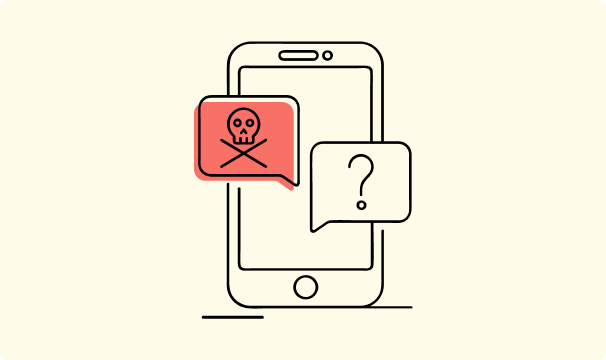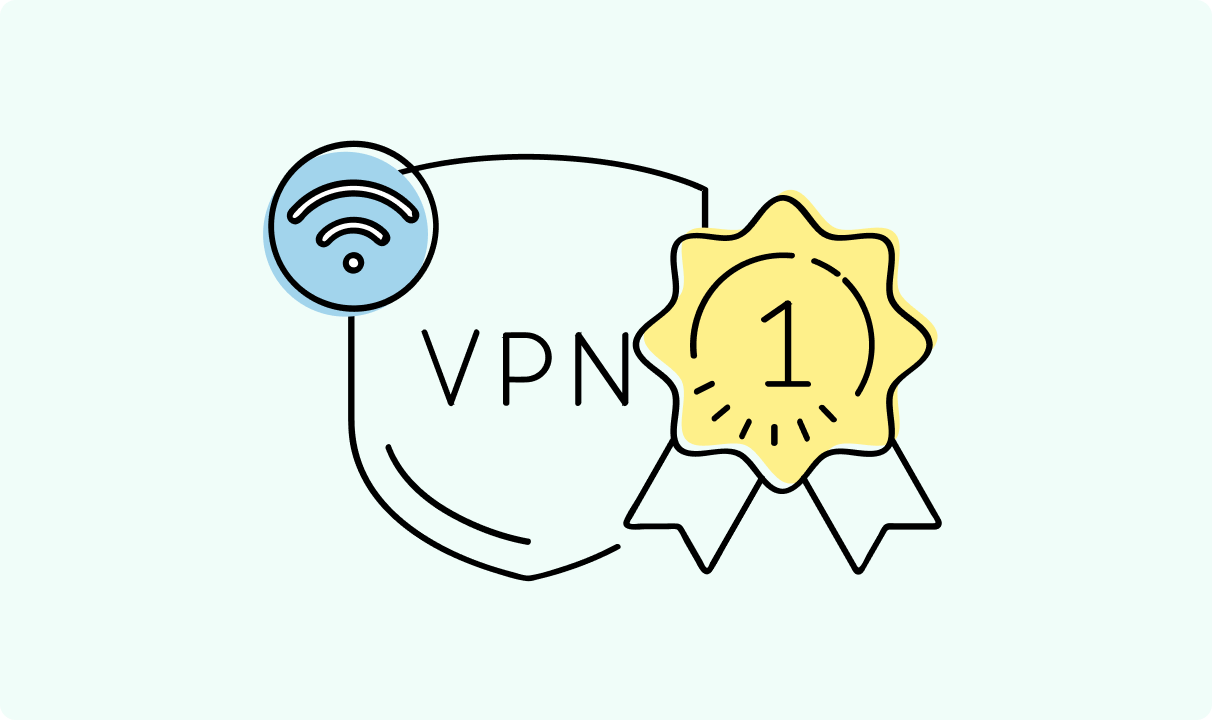How to Know If Your Phone Is Hacked: 7 Warning Signs
Key takeaways:
- Sudden warnings, ads, messages, power usage or performance issues, and settings changes may signal your phone is hacked.
- Phones can be hacked by attacks based on social engineering, such as phishing, and more sophisticated exploits requiring minimal human interaction.
- It's crucial to immediately disconnect your phone from the internet, change all passwords, and remove suspicious files or apps.
- Run a mobile security scan or run a full reset of the phone if nothing else helps.
- Preventing phone hacks relies on updating your software, avoiding third-party app stores and public Wi-Fis, and being cautious with online links.
Realizing your phone has been hacked is much more than an inconvenience. From storing pictures of your cat to accessing your bank account and making purchases, we rely on smartphones for almost everything.
The more you use your smartphone, the more important it is to know how to spot, fix, and prevent malware attacks. Most hacks on Android and iOS devices can be reversed, so once you suspect something, it's important to stay calm and take immediate action.

Guoda Šulcaitė
7 min read

How to Know If Your Phone Is Hacked: 7 Warning Signs
1. Rapid Battery Drain and Overheating
Malicious apps aren't optimized for battery usage. If your phone isn't particularly old or has known battery issues, the time between charges should remain consistent with casual use. Increased power consumption can be a sign of malware and might even cause the phone to overheat.
2. Sudden Spike in Mobile Data Usage
A sudden spike in mobile data usage also reflects suspicious activity. Most modern malware keeps a line of communication with the hacker's server to perform malicious acts. If you aren't using your phone's internet connection and it still uses a lot of data, it might be a sign that your device has been hacked.
3. Phone Running Slow or Apps Crashing
Performance issues, such as crashing apps or unusually slow loading times, might be signs that your phone has been hacked or infected with malware. Unless your smartphone is over the replacement age, sudden lowered performance of critical parts like RAM or CPU is likely caused by malicious apps.
4. Unexpected Ads or Pop-Ups
The sudden appearance of ads in apps, websites, or menus is one of the clearest signs your phone is infected with viruses. It might mean a specific type of adware or browser hijacker, but it could also be a more powerful malware. Take action immediately, and don't ignore it.
5. Unknown Apps or Settings Changes
Setting changes you haven't initiated or appearance apps you haven't downloaded may mean someone else has control over your smartphone. Often, the apps aren't officially supported on the app store, and the settings are related to security and privacy. Even if it looks harmless at first, don't ignore these signs.
6. Suspicious Calls or Texts You Didn’t Send
Outgoing text messages or calls you haven't made can be a warning sign of malware at work. Techniques such as SIM cloning or remote control are used by hackers to perform these actions. It's one of the most significant security and privacy threats resulting from your phone being hacked.
7. Security Tools Disabled or Warnings Triggered
Even if you don't use a dedicated antivirus, malware is likely to trigger smartphone security warnings. Hackers go to great lengths while shutting down antivirus software or limiting other ways you could fight back. If your malware warnings appear or security settings are getting disabled, it might be a sign your device is hacked.
How Phones Get Hacked
Phishing and Social Engineering
People are the weakest link in cybersecurity. Malicious links in emails, messaging apps, social media sites, and on the web are some of the most common ways malware gets installed.
Sometimes, the suspicious messages are easy to notice, but they might be socially engineered to target even the most tech-savvy of us.
The best defense is to adopt a zero-trust mindset, always verifying the authenticity of messages before taking action. Such threats are only likely to get more effective with the growth of AI-generated content in hacking and scam attempts.
Malware and Spyware Apps
Malicious software is often disguised as legitimate applications. Users can unknowingly install such apps from unofficial, third-party sources, opening the door for harmful activities.
Other ways such spyware can be unknowingly installed are by connecting to public Wi-Fis, unknown USB cables (e.g., free charging stations), or visiting malicious links.
Some hidden malware types might be disguised as an entry point for downloading further malicious software to your device. Even if there is no unusual activity at first, the signs may appear later.
SIM Swaps and Identity Takeovers
Fraudsters may use already acquired data to impersonate other people and spread malware. They could pretend to be your friends, coworkers, or various service providers to perform phishing attacks, but it could also work the other way around.
One of the most damaging attacks is SIM swapping. An impersonator might contact your mobile service provider and transfer your SIM data to their device. This may allow him to access not only your calls and texts but also 2FA security measures or link various accounts, such as banking, to his control.
Zero-Click Exploits and Silent Attacks
Silent attacks encompass a variety of ways hackers use to infiltrate devices without triggering warnings or being detected. These attacks prioritize long-term espionage of the user to avoid getting noticed at all costs. Zero-click exploits are a type of silent attack that's the most difficult to defend from.
Advanced techniques are used by expensive software, such as Pegasus Spyware, to gain access to a device without user interaction. Instead, such spyware uses security flaws and vulnerabilities of already installed programs to infiltrate the device.
What to Do If You Think Your Phone Is Hacked
Disconnect Immediately (Wi-Fi & Mobile Data)
The first thing to do after noticing your phone has been hacked is to disconnect it from Wi-Fi and mobile data. It will cut off the ability of the malware to communicate with the hacker's servers and perform further actions. The rest is mitigating the damage and removing viruses.
Change All Important Passwords
Hackers might still have access to your accounts with the passwords they stole. Change all the passwords and 2FA authentication procedures of critical accounts – banking, email, social media, e-commerce shops, and everywhere else you can think of. It's important to perform these changes on another secure device.
Make sure to use a different device to do so, in case your phone is actually compromised. Otherwise, all of your new passwords may leak again.
Monitor Accounts and Contact Service Providers
Keep an eye on changes to the most important accounts and notify the service providers that the security has been compromised. When contacting banks, for example, you might need to make some phone calls. Other services, such as Google or Apple accounts, have dedicated settings for flagging log-ins as exposed.
Identify and Remove Suspicious Apps
Once your accounts are safe, you can take steps to remove malware. Start by booting the device in safe mode, if possible. It disables recently installed and non-critical apps, making it easier to remove malicious apps. Instructions for turning on safe mode vary by device.
Generally, Android devices enter safe mode when you reboot them while holding the volume button down. iOS devices, except jailbroken ones, do not have a safe mode, but you should still at least restart them.
Next, open the Google Play Store or Apple App Store, filter by recently installed apps, and uninstall them one by one. You should also open the file manager and delete suspicious files that appeared around the time your phone started showing signs of malware.
Run a Mobile Security Scan
It is recommended to run a mobile security scan on your device. You might need to download a reputable antivirus software, such as Avast or AVG. Some Android devices, such as Samsung or Xiaomi smartphones, have built-in antivirus apps you can use to scan your files. If the antivirus finds any threats, remove the associated files.
Factory Reset as a Last Resort
Performing a factory reset of your device is usually the only option when the infected files cannot be removed. Since it will wipe out your data and apps as well, make a backup copy first.
It can be done by connecting your phone to a PC or using cloud services. Be careful not to back up already infected files, so malware doesn't return.
How to Prevent Your Phone From Getting Hacked
Keep Software and Apps Updated
Many updates to the operating system and various apps are intended to fix security vulnerabilities that attackers may exploit to infect your device. It is important not to delay these updates, as doing so leaves your phone vulnerable to being hacked.
Install Only From Official App Stores
Third-party app stores or other websites hosting install applications for smartphones are not worth the risk. Apps from such sources haven't been verified by the app store and aren't actively scanned by features like Google Play Protect. Using only the official store closes most attack methods used by hackers.
Use Strong Passwords and Two-Factor Authentication
While using strong passwords and 2FA authentications won't save you from malware, they help to mitigate the damage after your phone is hacked. Using only one password or its variation will make it much easier for attackers to take over your accounts.
Be Cautious With Links and Attachments
Avoid opening suspicious messages or links in social media apps or emails. No matter how convincing the text might sound, always double-check whether the exact URL is leading where it's supposed to. Exercising caution online is the best way to defend your privacy and device security.
Use a Mobile VPN on Public Wi-Fi
Public Wi-Fi networks in places like airports and cafes tend to be vulnerable to attacks. Hackers can infiltrate such networks to spy on their users or spread malware. If you use CometVPN, your phone will be safer as all the data will be encrypted and routed through our servers.
Final Thoughts & Next Steps
Many other tips, such as regularly reviewing installed apps, using a lock screen and SIM lock, and avoiding public USB charging stations, can also be applied. Most of them originate from common-sense practices online. The tips outlined here will help you notice and act swiftly when your phone is hacked.

Author
Guoda Šulcaitė
Growth Manager at CometVPN
Guoda is an all-round marketing professional with deep knowledge in the tech SaaS industry, particularly VPNs and proxies. She has worked on numerous projects and helped achieve impressive results through project management, content production, and SEO.
Related articles

4 min read
Best Residential VPN Providers in 2025
A Virtual Private Network (VPN) encrypts your traffic and hides your IP address. The way these functions are accomplished affects various aspects of your online privacy and security.
Here, we'll consider using residential IP addresses instead of those originating from a data center. A residential VPN has advantages compared to traditional ones, but there are some caveats. It all boils down to residential VPN providers.
The worst ones may even create more risks than benefits. We'll end this article with a list of the best residential VPN providers on the market.

Guoda Šulcaitė
4 min read
Ethernet vs Wi-Fi: Which One is Better?
Ethernet and Wi-Fi are the two main ways to connect your computer to the internet. While Wi-Fi has received significantly more attention in recent years, especially among consumers, due to its simplicity and flexibility, ethernet is still widely used in various other applications.
Even if Wi-Fi is significantly more popular, it isn’t strictly better. Both methods have their benefits and drawbacks. Wi-Fi’s popularity comes from its ease-of-use and flexibility, but an ethernet connection can be much more useful in certain scenarios.

Adomas Šulcas

5 min read
How to Change Chrome Proxy Settings: The Ultimate Guide
A proxy server is an easy alternative to a VPN that can perform most of the functions of the latter. It’s a server that stands between your device and the destination server, taking your connection requests and forwarding them in your name.
Destination servers in almost all cases see the proxy server as the originator of the request. As such, proxies are widely used in various, mostly business-related applications whenever privacy, security, location changing, and several other factors are at play.

Guoda Šulcaitė